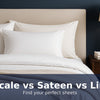The Ultimate UK Duvet Tog Guide
- by Anthony West
The Ultimate UK Duvet Tog Guide: Pick the Perfect Warmth for Every Season
Not sure which duvet tog to choose? This UK-focused guide explains what “tog” really means, how to match warmth to the British seasons (and your bedroom temperature), and the pros and cons of popular fills like down, wool, silk and microfibre. By the end, you’ll know exactly which duvet to buy for you, your family and your guest room.
What does “tog” mean?
Tog is a measure of thermal insulation—how well a duvet traps warm air. A higher tog = warmer duvet. It doesn’t measure quality; it only measures warmth. Quality is driven by the fill (e.g., goose down vs microfibre), the construction (baffle box vs stitched-through), and the fabric.
- Low tog (1.5–4.5): cool/summer
- Medium tog (7.5–10.5): spring/autumn, most year-round bedrooms
- High tog (12–15): winter, very cool rooms or cold sleepers
For versatility, many UK households love an all-season set (e.g., 4.5 tog + 9.0 tog that popper together for ~13.5 tog in winter). Explore our range: Shop duvets at Snuggery.
Quick chooser: match tog to bedroom temperature
Use your typical night-time room temperature as your anchor. If you sleep hot or cold, adjust one step down or up.
| Bedroom Temp (°C) | Best Tog | Notes |
|---|---|---|
| 22–24°C (very warm/loft apartments, heat on overnight) | 1.5–3.0 tog | Ultra-light summer duvets; hot sleepers may prefer a top sheet. |
| 19–21°C (typical modern home in summer) | 4.5 tog | Classic UK summer choice. |
| 16–18°C (most UK bedrooms spring/autumn) | 7.5–10.5 tog | The “safe” year-round zone for mixed sleepers. |
| 13–15°C (cool rooms/winter) | 12–13.5 tog | Cosy for cooler sleepers; consider an all-season set. |
| ≤12°C (very cold rooms, period homes) | 15 tog | Maximum warmth; pair with brushed cotton bedding. |
Pro tip: If your temperatures swing through the year, choose an all-season (4.5 + 9.0 tog) and split/clip as needed.
By sleeper type
- Hot sleepers / night sweats: 1.5–4.5 tog, breathable fills (linen sheets, light microfibre or high-loft down with lower tog). Keep the room at 16–18°C if possible.
- Cold sleepers / poor circulation: 10.5–13.5 tog, consider down or wool for superior warmth-to-weight; brushed cotton duvet covers help.
- Couples with different needs: all-season duvets (use only one layer on one side), or Scandinavian “two single duvets on a super king” approach.
- Kids: 4.5–7.5 tog generally works; avoid heavy 13.5–15 tog for very young children.
- Guest rooms: 9–10.5 tog is the most forgiving across seasons and visitors.
Fill types explained (pros & cons)
Down & Feather
Why people love it: unmatched warmth-to-weight and cloud-like drape. Look for fill power (higher = loftier) and baffle-box construction to stop clumping.
- Pros: light, luxurious, long-lasting when cared for
- Cons: higher price; not ideal for some allergies (choose hypoallergenic down or microfibre instead)
Microfibre / Hollowfibre
Modern synthetics that mimic down’s loft, often at a friendlier price and with easy care.
- Pros: hypoallergenic options, machine-washable, quick to dry, good value
- Cons: slightly heavier for the same warmth, can compact faster than premium down
Wool
Natural temperature regulation—warms when cold, breathes when warm. Great across UK seasons.
- Pros: excellent moisture management; naturally hypoallergenic; durable
- Cons: heavier “handfeel”; typically spot-clean or specialist clean
Silk
Light, breathable, and naturally cool to the touch—beautiful for warm sleepers.
- Pros: luxurious drape, breathable, dust-mite resistant
- Cons: premium price; gentle care required
Browse by fill: Down & Feather · Microfibre · Wool · Silk
Construction matters (as much as tog)
- Baffle box: internal walls create full chambers—best loft, least cold spots.
- Stitched-through: lighter and often cheaper; fine for lower togs.
- Edge piping & box-stitching: help longevity and even fill distribution.
- All-season poppers: ensure both layers align perfectly without shifting.
Size guide (UK)
| Bed Size | Duvet Size | Notes |
|---|---|---|
| Single | 135 × 200 cm | Ideal for kids/guests |
| Double | 200 × 200 cm | Cosy for couples in warmer rooms |
| King | 225 × 220 cm | Most popular for couples |
| Super King | 260 × 220 cm | Luxury drape, fewer duvet wars |
Finish the look with our duvet covers and pillows in percale, sateen or linen.
Care & storage (make it last)
- Air your duvet monthly; sunlight helps refresh and reduce odours.
- Use a protector to shield from spills and sweat—easy to wash.
- Follow the label: down often needs large-capacity washing/drying; synthetics are usually machine-washable at home.
- Fluff regularly to maintain loft. For down, tumble with clean dryer balls on low heat.
- Store for summer in a breathable cotton bag (avoid vacuum compression for down; synthetics tolerate it better).
One-minute duvet chooser
Room usually 16–18°C? Choose 10.5 tog (or an all-season 4.5 + 9.0 if your temps swing).
Hot sleeper / summer flat? 3–4.5 tog in breathable fill.
Cold sleeper / draughty room? 12–13.5 tog (or clip your all-season together).
Guest room? 9–10.5 tog works for most visitors.
Shop All Duvets Browse Duvet Covers
FAQs
What tog is best for summer in the UK?
4.5 tog suits most UK summers. If your bedroom sits above 21°C or you sleep very hot, drop to 1.5–3.0 tog.
What tog is best for winter?
A cosy 12–13.5 tog is the UK winter sweet spot for cool rooms (13–15°C). For very cold rooms, go up to 15 tog.
Is 10.5 tog warm enough all year?
For many UK homes, yes—especially in bedrooms between 16–18°C. If your temperature swings, choose an all-season 4.5 + 9.0 tog for flexibility.
Down vs microfibre—what feels more luxurious?
Premium down offers the lightest, cloud-like loft. High-quality microfibre is excellent value, hypoallergenic and easy care. Both can be luxurious; it’s down to preference and budget.
How long should a good duvet last?
With regular airing and correct washing, a quality duvet lasts 5–10 years (down can last even longer). Use a protector to extend life.
Finish with the right bedding
Warmth is half the story—fabric feel matters too. Pair your new duvet with: cool percale sheets for crispness, silky sateen for hotel sheen, or air-washed linen for breathable, relaxed luxury.
Note: Tog is a warmth guide; personal comfort varies with pyjamas, mattress, and bedroom ventilation. If you’re between togs, choose an all-season set for easy flexibility.



